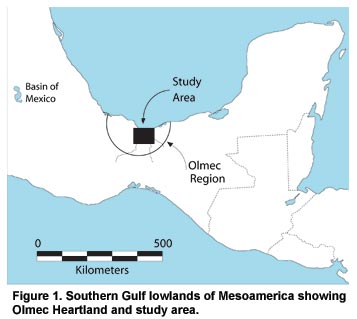
| FAMSI © 2006: Carl J. Wendt |
||
Bitumen Sourcing in the Olmec Region Introduction Although there has been a considerable amount written on the Olmec (Figure 1; Table 1), there are relatively few good data on material procurement strategies, regional exchange, and interaction networks within the Olmec region. Obsidian and clay are among the few commodities utilized in ancient Mesoamerica that have been chemically studied to determine their source location and patterns of exchange (Blomster et al. 2005; Cobean 2002; Neff 2003; Stoltman et al. 2005). And while bitumen use was common, archaeological studies of sources have never been carried out. In the present study, I set out to determine if bitumen could be used to help understand the organization of Olmec material procurement systems, and whether archaeological specimens can be related to natural sources. Geochemical data were gathered on bitumen collected from seeps and archaeological sites in the Olmec region. Samples were compared using Gas Chromatography/Mass Spectrometry (GC/MS) to determine if bitumen from natural seeps in the study area is chemically different and if there exists a good correlation between natural seep bitumen and archaeological bitumen. Insights on procurement and trade will allow for the evaluation of hypotheses on intra- and inter-regional exchange and interaction (e.g., Blomster et al. 2005; Flannery et al. 2005; Flannery and Marcus 2000; Grove 1994; Hirth 1984), which will in turn contribute to our current understanding of the development and organization of regional economic systems. |
||
|
Text links to all pages at this site are available at the FAMSI INDEX |
||
